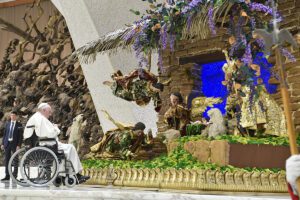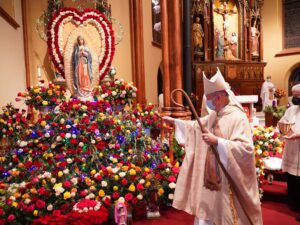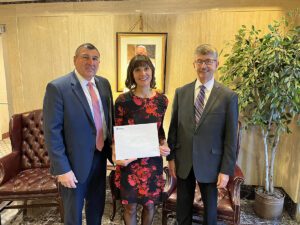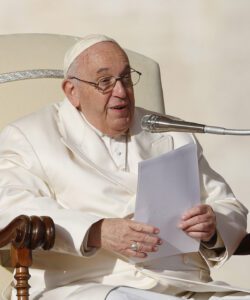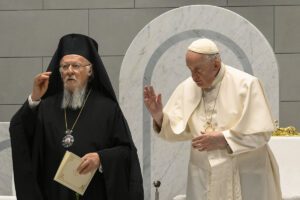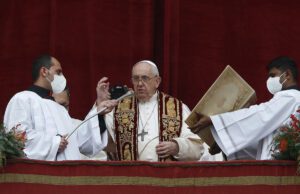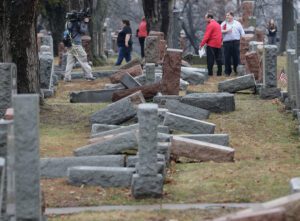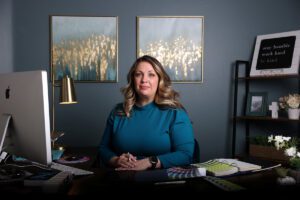
WASHINGTON (CNS) – In a case examining the scope of free speech protected by the First Amendment, the Supreme Court Dec. 5 ultimately seemed to favor a broad view of free speech.
And in this case, the speech involved what a graphic designer who creates websites should not have to say.
Colorado designer Lorie Smith, who runs a web design company called 303 Creative, has said she should not be required to create wedding websites for same-sex couples based on her Christian beliefs about marriage.
Colorado state law forbids businesses from discriminating based on sexual orientation. Smith contends her First Amendment right to free speech exempts her from the law.
But she lost her case in the lower court when the 10th U.S. Circuit Court of Appeals ruled that the state has a compelling interest to protect its citizens “from the harms of discrimination.”
Kristen Waggoner, the Alliance Defending Freedom attorney representing Smith, before the Supreme Court, specifically argued that companies whose work centers around expression have First Amendment protections from being compelled to say things that go against their personal beliefs.
If Smith’s case sounds familiar, that’s because it is very similar to a recent case involving a Colorado baker who refused to make a custom wedding cake for a same-sex couple based on his religious beliefs.
In 2018, the Supreme Court ruled that the baker’s refusal to make a wedding cake did not violate Colorado’s anti-discrimination law.
In its ruling, the court did not specifically deal with First Amendment protections allowing businesses to refuse clients’ requests based on the owners’ religious convictions.
A ruling in favor of the web designer in this case could give broad leeway to business owners to deny services based on their own beliefs and would trump anti-discrimination laws.
The U.S. Conference of Catholic Bishops, joined by the Colorado Catholic Conference and other religious groups, sided with the designer as they did with the baker five years ago. In their amicus brief they said this case gives the court the chance to clarify free speech issues it said the court fell short of doing in the previous case, Masterpiece Cakeshop v. Colorado Civil Rights Commission.
In the current case, Smith, has not denied a service as the baker did in refusing to bake a custom cake for the same-sex couple. Smith is asking the court to weigh in before she even begins designing wedding websites, saying she has been worried that her refusal to design a same-sex wedding website would violate Colorado’s public accommodations law.
Some of the justices brought up hypothetical cases that could come up if they ruled in the state’s favor asking Colorado Solicitor General Eric Olson if people could be forced to write news releases for the Church of Scientology or a Black Santa actor could be forced to pose with a child in a Ku Klux Klan outfit — incidents that Olson said would not apply under the state’s law.
Conversely, Justice Sonia Sotomayor asked if a ruling in favor of the designer would mean web designers could refuse to work with interracial couples or disabled couples.
A majority of the justices seemed willing to carve out narrow exemptions to discrimination laws.
Justice Clarence Thomas emphasized that this case was distinct from other public accommodations cases because of the speech aspect, pointing out: “This is not a hotel, this is not a restaurant, this is not a riverboat or a train.” Similarly, Justice Brett Kavanaugh asked about how one would determine even within the wedding industry what types of services count as speech.
In response, Waggoner told the court she wouldn’t be in front of them today representing a caterer, for example, but she would likely represent a custom wedding cake designer, bringing the previous court case to mind.
The USCCB’s brief said there is a “pressing need for the court to clarify how the compelled speech doctrine applies to wedding-vendor cases and other disputes.” It urged the justices to do what they have done in the past: “Apply the Free Speech Clause to protect religious speech, thereby strengthening liberty not just for the religious but for all society.”
It also said the current case “provides an appropriate and especially important opportunity to invoke free speech protections again to address the ongoing tensions in wedding-vendor cases and in the current cultural context more broadly” and implored the court to “protect individuals from compelled speech and to provide space in the public square for minority voices.”
Other groups that filed briefs on behalf of the wedding vendor included Catholicvote.org, the Thomas More Society, the Catholic League for Religious and Civil Rights and the Becket Fund.
DignityUSA, an unofficial Catholic support group for gay Catholics and their families, and New Ways Ministry, a Catholic pastoral outreach to LGBTQ people and their families, joined a brief filed by 30 religious and civil rights groups opposing the graphic artist’s case.
“Carving out this broad exemption would allow public businesses to legally exclude customers based on their identities,” it said, adding that “instead of safeguarding every citizen’s right to buy goods and services from businesses open to the public,” the proposed exemption “would further hurt the very people these civil rights laws were designed to protect.”
Twenty states supported Smith in friend of the court briefs. They say that they have public accommodation laws on the books, but their laws exempt those businesspeople who make their living creating custom art. Twenty-two states support Colorado and have similar laws in place protecting people from discrimination, which is also backed by the Justice Department.
A decision in the case is expected in late June.
Cathedral hosts large celebration in honor of Feast of Our Lady of Guadalupe
SCRANTON – It has been nearly five centuries since God sent Mary as his messenger – appearing before Blessed Juan Diego, an Aztec Indian – but the importance of that apparition continues to inspire generations.
On Sunday, Dec. 11, hundreds of people filled the Cathedral of Saint Peter to celebrate the Feast of Our Lady of Guadalupe. The Cathedral celebration, organized by the parishes of Saint John Neumann and Saint Paul of the Cross in South Scranton, was moved downtown to draw even more people from across the city.
“It was an amazing event. We had a very big crowd come out,” Adriano Torres explained. “If we want to grow this community, it is so important to do events like this.”
The Most Rev. Joseph C. Bambera, Bishop of Scranton, served as principal celebrant for the Mass, which was followed by a festival across the street at the Diocesan Pastoral Center.
“It is with the deepest gratitude that we thank the bishop for celebrating this Mass with us and for the people of the Cathedral who let us use their wonderful church,” Father Jonathan Kuhar, pastor of the South Scranton parishes, said.
The annual Feast of Our Lady of Guadalupe commemorates the appearance of the Virgin Mary to Juan Diego on December 9, 10 and 12, 1531 in Tepeyac, near present-day Mexico City. The Blessed Mother’s appearance is believed to have resulted in millions of conversions to Catholicism.
Deysi Fuentes attended the Cathedral Mass and celebration with her family, including several children.
“We have to teach our youth our traditions. We guide them in faith towards God,” she explained. “It is a way to show our children where we come from and our traditions that enrich our countries.”
Fuentes pointed out that a milestone anniversary for Our Lady of Guadalupe is quickly approaching.
“We are nine years away from celebrating the 500th anniversary of the first time she appeared to Juan Diego,” Fuentes said.
While the Feast of Our Lady of Guadalupe is especially important to Hispanics, Father Kuhar reminds everyone that she is the Patroness of the Americas, and we should all celebrate her.
“She is our patroness, all of us – North (America), South (America) and Central America – and it is a wonderful thing that we get to celebrate her all together in Scranton,” he said.
In addition to the Cathedral Mass in Scranton, Bishop Bambera also celebrated Mass for the Feast of Our Lady of Guadalupe on Monday, Dec. 12 at Saint Nicholas Parish in Wilkes-Barre. Prior to the Mass, the faithful spent two hours processing through the streets of the Diamond City with a statute of the Blessed Virgin Mary.
Parishes in East Stroudsburg, Meshoppen, Jermyn and Hazleton also held Feast Day celebrations.
“At a time when they needed a savior, Mary brought to them the Good News,” Father Kuhar added.
Hundreds of people gathered for the Feast of Our Lady of Guadalupe Mass at the Cathedral of Saint Peter in Scranton on Dec. 11, 2022. (Photos/Mike Melisky)
Guadalupana Torch arrives
at Saint Matthew Parish
EAST STROUDSBURG – In what has become an important community tradition, the Guadalupana Torch arrived in the Poconos on Sunday, Dec. 4, just days before the Feast Day of Our Lady of Guadalupe.
The torch, officially known as Carrera Antorcha Guadalupana, begins its journey each year in Mexico City, crosses the border into the United States and ends in New York City.
For the last several years, parishioners from Saint Matthew Parish in East Stroudsburg have welcomed the torch into the Diocese of Scranton as part of its long journey.
“It’s a special event. Everybody is included,” parishioner Karla Carrasco, said.
Carrasco said the torch has special significance, connecting families who have relatives on both sides of the United States-Mexico border, that cannot be together for one reason or another.
“All of those people that touch it and bear it and all those families from Mexico who aren’t able to be with their families here in the United States, they are able to touch the torch and know that their loved ones touched it in Mexico,” she explained.
Stephanie Albuja came back from college just to see the Guadalupana Torch arrive locally this year. She participated in a procession with the torch through the streets that ended at Saint Matthew Parish.
“I think it’s very important to have events like this in public because it attracts other people that aren’t from the parish or are from other churches and they can all come and celebrate with us,” Albuja said.
Keyla Carrasco emphasized the torch procession is not just for the Hispanic community.
“It is incredible seeing everyone gathered together, different colors, different races,” she explained. “It is something that touches everybody when they see the replica of the Blessed Virgin Mary that accompanies the torch.”
Carrasco said she grows in her faith each year by participating in the torch procession.
“You see you’re not alone in your faith,” she explained.
Miguel Vaca, who came to the Poconos nearly 30 years ago, is happy to see more people getting involved in the procession each year.
“We have not only Mexican people, but we have people from Ecuador, Colombia, Venezuela and all those countries that speak Spanish,” Vaca said. “We get together and we experience the love that we give to the Virgin Mary and the love that the Virgin Mary gives to us.”
Parishioners of Saint Matthew Parish escort the Guadalupana Torch through the streets of East Stroudsburg on Sunday, Dec. 4, 2022. Each year, the torch begins its journey in Mexico City and ends in New York.
Chinellos lead dancing at a festival following Mass at the Diocesan Pastoral Center in Scranton.

